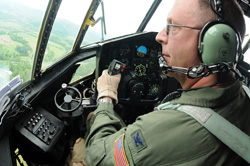In the hot seat: an Air Guard pilot’s view of flying wildfire missions
When wildfires break out across the landscape, they often leave behind a path of scorched terrain and charred remains of homes in the path of the destructive blaze.

Air Force Col. Roger Williams Jr., an instructor pilot with the 156th Airlift Squadron, North Carolina Air National Guard, skirts above the treetops at about 150 feet in a C-130 Hercules aircraft as he locks in on a U.S. Forest Service lead plane during wildland fire suppression training mission in Pisgah National Forest, N.C., May 9, 2012. The aircraft Williams flew was equipped with the Modular Airborne Fire Fighting System II, a tanking system that can hold up to 3,000 gallons of retardant or water used to create firebreaks during aerial wildfire suppression. MAFFS pilots follow lead planes as a guide to aid them with where to lay these firebreaks for maximum effectiveness.
As a way to help contain and put out those fires, U.S. Forest Service officials often call upon the Air National Guard for assistance. That includes pilots like Air Force Col. Roger Williams Jr., an instructor pilot with the 156th Airlift Squadron, North Carolina Air National Guard.
Williams has been supporting civilian first responders in the fight against wildfires since 2003.
Flying a C-130 Hercules equipped with a Forest Service-owned Modular Airborne Fire Fighting System II – an onboard tanking system that can hold up to 3,000 gallons of retardant or water – Williams said a lot of the skills that pilots use in Afghanistan and other deployed locations directly relate to what they need to do during a MAFFS mission.
Following a lead plane towards the area of devastation, Williams said they talk to the guys fighting the fire on the ground and.
“What they’re doing is painting a battlefield picture,” said Williams, who has been flying wildfire missions since 2003. “And with that picture they decide where to put that 3,000 gallons of retardant by giving us the coordinates.”
Skills like performing low altitude airdrops and flying in formation are what Williams said make the MAFFS mission just like flying into combat.
And with those on the ground dependent upon the support they get from the air, Williams said he there are similar feelings here saving homes and property, lives and the forest as in combat.
“When you fly in and see a bunch of acreage taken out by the flames – you just want to get in there and stop it from doing any further damage,” he said.
Calling the mission enjoyable but disheartening, he said that for him, it’s one of the best feel-good missions the Guard does, and most MAFFS pilots agree.
The Forest Service has said they expect this year to be more active than last, and they expect to be calling upon the Air Guard and pilots like Williams to help suppress wildfires and save property, lives and the forest before it’s too late.
source: U.S. National Guard Bureau Guard News
- 1026 reads
Human Rights
Fostering a More Humane World: The 28th Eurasian Economic Summi

Conscience, Hope, and Action: Keys to Global Peace and Sustainability

Ringing FOWPAL’s Peace Bell for the World:Nobel Peace Prize Laureates’ Visions and Actions

Protecting the World’s Cultural Diversity for a Sustainable Future

Puppet Show I International Friendship Day 2020

